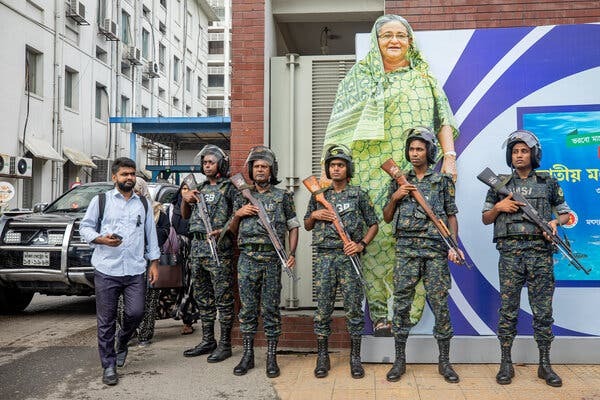
Pakistan, Sri Lanka and Bangladesh have a dark history of coups. These three countries are important countries of South Asia and all three have seen coups many times in history. In these countries, deep differences and mistrust between political parties often lead to coups. The army has always dominated all three countries. This is the picture of coups that is being seen in Bangladesh at this time.
Prime Minister Sheikh Hasina had to resign and take refuge in India. Now Bangladesh is in the hands of the army. Let us tell you about the coups that took place in Bangladesh, Sri Lanka and Pakistan.
Why does the government bow down?
First let us talk about the reasons due to which these countries have to face the brunt of coups. The most common reason is the severe economic crisis. Due to the economic crisis, people turn against the government and the army or other groups try to seize power. Religious and ethnic tensions have also been the cause of coups in these countries. Sometimes foreign countries also interfere in the internal politics of these countries and promote coups.
Puts a brake on development
The development of these countries has always been affected due to coups. Coups increase political instability and stop the development of the country. Coups have a bad effect on the economy and reduce foreign investment. Human rights are often violated during coups. Coups increase divisions in society and spoil social harmony.
Coup in all three countries
Talking about Pakistan, military coups have been common there. Here the army has seized power many times. There have been coups in Sri Lanka as well, but political crises have been more common here than military coups. The latest developments in coups are being seen in Bangladesh. There have been fewer military coups in Bangladesh, but due to the problem of political instability and economic crisis, the situation has worsened many times. Something similar is being seen this time as well.
Bangladesh Coup
People are on the streets in Bangladesh for reservation. There has been a ruckus in the country for the past one month on the issue of reservation. Now the situation has come to such a pass that the people of the country have challenged the system. Seeing the protest of the people and increasing violence, Prime Minister Sheikh Hasina had to resign from her post and leave the country. So far reports are saying that to control the situation, the army itself had asked Hasina to resign. Bangladesh has seen coups before.
Let us tell you about the major events of the Bangladesh coup.
1975 coup
The assassination of Bangladesh’s first president Sheikh Mujibur Rahman and the overthrow of his government took place on 15 August 1975. Army officers staged a coup and removed him from power. After this, Major General Ziaur Rahman took power and Bangladesh was ruled by a military regime.
1981 attempt
Ziaur Rahman was assassinated in 1981, after which some army officers attempted to seize power. However, this attempt was not successful and Bangladesh returned to democracy through elections. In 1990, a massive civil movement in Bangladesh ended the then military rule and paved the way for the return of democratic government.
There have been many coups in Pakistan
If we talk about Pakistan, coups are common here and the reason behind it has always been the army.
First coup of 1958
In 1958, Pakistan’s President Iskandar Mirza appointed General Ayub Khan as the head of the army and then suspended the constitution. Ayub Khan then staged a coup in 1958 and became the President of Pakistan. He imposed a military rule and introduced a new constitution in 1962, which increased the powers of the President.
1969 – Second coup
In 1969, Pakistan’s General Ayub Khan resigned from power and General Yahya Khan took over. Yahya Khan imposed another military rule and held general elections in 1970. After which East Pakistan (now Bangladesh) freed itself.
1977 – Third coup
In 1977, Pakistan’s General Zia-ul-Haq staged a coup, ousting the government of Prime Minister Zulfikar Ali Bhutto. Bhutto was arrested and later sentenced to death. Zia-ul-Haq imposed a strict Islamic law in the country and remained in power until his death in 1988.
1999 – Fourth coup
In 1999, Pakistan’s General Pervez Musharraf staged a coup, ousting Prime Minister Nawaz Sharif’s government. Musharraf imposed military rule in the country and declared himself president. In 2001, he cooperated with the US in the war against terrorism. In 2008, he resigned and democratic government returned.
Attempts have been made to shake the government in Sri Lanka too
Now let’s talk about Sri Lanka.. There have been fewer incidents of coups in Sri Lanka as compared to Pakistan and Bangladesh. In 1962, the army in Sri Lanka attempted a coup. Military officials and some civilian officials tried to remove the government of the then Prime Minister Mrs. Srimavo Bandaranaike. This attempt failed and many officials were arrested.
Political crisis in Sri Lanka in the 2000s
There have been no major military coups in Sri Lanka, but the country experienced major political and social instability during the 1980s and 1990s. The Sri Lankan Civil War (1983–2009) brought about several political crises, including violent conflicts between the Tamil Tigers (LTTE) and the government.
2018 constitutional amendment controversy
In 2018, President Maithripala Sirisena suddenly sacked Prime Minister Ranil Wickremesinghe and appointed former President Mahinda Rajapaksa as the new Prime Minister. This move caused great controversy and protest. The Supreme Court declared Sirisena’s decision unconstitutional and Wickremesinghe was reappointed as Prime Minister.
 Lucknow Press
Lucknow Press
